The Philippines is trying to mix culture and change in a special way. Filipino families are trying to keep their rich culture alive while living in today’s world. This mix of old and new is what makes Filipino society unique.
Filipinos are amazing at keeping their cultural identity while accepting new things. They value family and faith deeply. This helps them respect their traditions and also welcome change.
Key Takeaways
- Filipino families balance traditional values with modern ideals, such as career choices and relationships.
- The digital revolution has created a digital literacy gap between generations, raising concerns about online safety.
- Overseas Filipino Workers (OFWs) play a significant role in shaping family dynamics through remittances and physical separation.
- Filipino culture is characterized by a strong sense of respect for elders and tradition, reflected in practices like the “mano” gesture and the use of terms like “po” and “opo”.
- The Philippines’ geographic diversity, with over 7,000 islands, contributes to a vibrant cultural landscape, with festivals like Sinulog and Ati-Atihan showing the country’s rich heritage.
- Filipino hospitality is known for its warmth and generosity, often shown through traditional dishes like adobo or bibingka and the communal eating practice of “kamayan”.
- The phrase “tabi-tabi po” reflects the country’s deep-seated beliefs in Filipino folklore and spirituality, highlighting the importance of respecting tradition and culture.
Understanding Modernity in the Filipino Context
In the Philippines, modernity is deeply connected to the country’s history and culture. As the nation moves forward, it’s key to grasp the values that define its modern identity. The Filipino view of modernity is special, blending Western influences with its own unique twist.
Education is vital in the Philippines, with schools seen as key to modernity. Private schools like AMA Computer University and STI have helped meet the need for tech skills. This has made higher education more accessible, creating vital digital age technicians. For more on modernization’s impact, check out this website about William Cameron Forbes’ legacy.
As the Philippines deals with modernity’s complexities, it’s important to look at the values driving its progress. Understanding how Filipinos see modernity helps us see the challenges and chances that come from mixing old and new values.
Historical Background of Modernity in the Philippines
The Philippines has a rich but complex history. Many colonial powers have shaped its culture and growth. The Spanish, American, and Japanese periods have all influenced Filipino society, forming its modern identity.
The American rule brought the Philippine public school system in the early 1900s. It was modeled after the American system. This change deeply affected the country’s education and culture.
Some key events that shaped the Philippines’ modernity include:
- The Spanish conquest of the Philippines in 1565
- The introduction of Islam in the 14th century
- The establishment of the Philippine public school system in the early 1900s
- The emergence of Filipino “modernist” writers in the 1920s
The Philippines’ history is marked by three empires: Spain, the United States, and Japan. This mix has created a unique culture and change that defines the Philippines today.
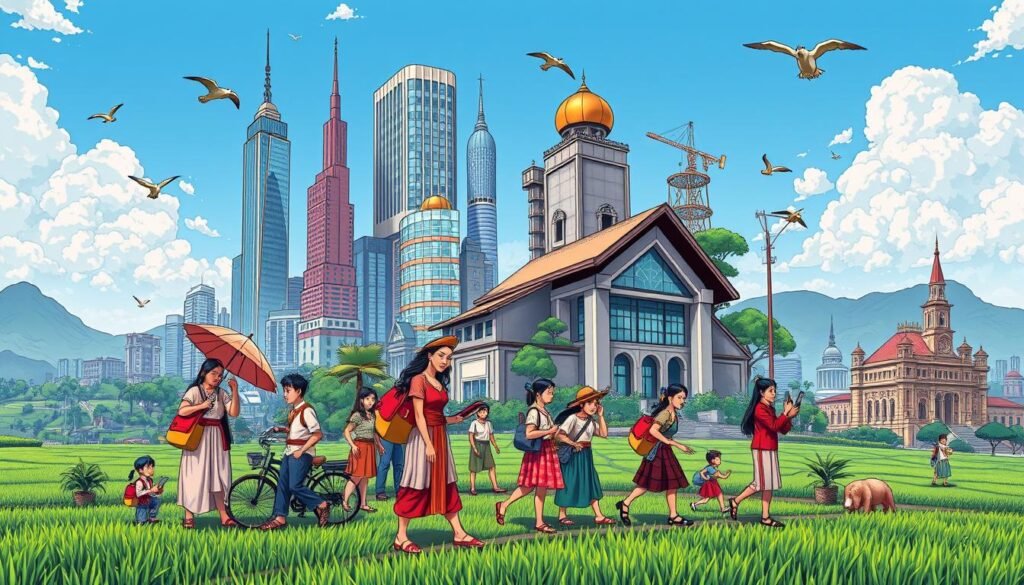
| Colonial Power | Period | Influence on Filipino Culture |
|---|---|---|
| Spain | 1565-1898 | Introduction of Christianity, establishment of a colonial government |
| United States | 1898-1946 | Establishment of the Philippine public school system, promotion of American culture |
| Japan | 1942-1945 | Occupation during World War II, influence on Filipino politics and economy |
Key Elements of Filipino Modernity
The Philippines is making progress in many areas of society. It’s important to look at what makes Filipino modernity special. Technology and staying connected are big parts of this. A study shows that social media and online chats have changed how families stay in touch and share information.
Urbanization is also key. It has made cities grow and changed how people live. Many Filipinos moved to cities for work, leading to more people and new businesses. A report from sinaunangpanahon.com talks about how education and infrastructure helped shape the country.
- Technology and connectivity
- Urbanization and its impact on lifestyle
- Changing values and cultural norms
These factors have helped the country grow and shaped who Filipinos are today. As the Philippines keeps changing, it’s vital to understand and value these modern elements.
The Role of Education in Modern Filipino Society
Education is key in shaping a society’s culture, and in the Philippines, it’s no different. The country’s education system has changed a lot, focusing on progress and change. The Philippine Journal of Education Studies publishes articles on education, like the K to 12 curriculum and teacher experiences.
The journal’s editorial board includes experts from around the world, like Dr. Geoffrey M. Ducanes from the Ateneo De Manila University. He specializes in applied econometrics. The journal offers new insights on education to a global audience. Education drives social change, and in the Philippines, it can lead to positive cultural shifts.
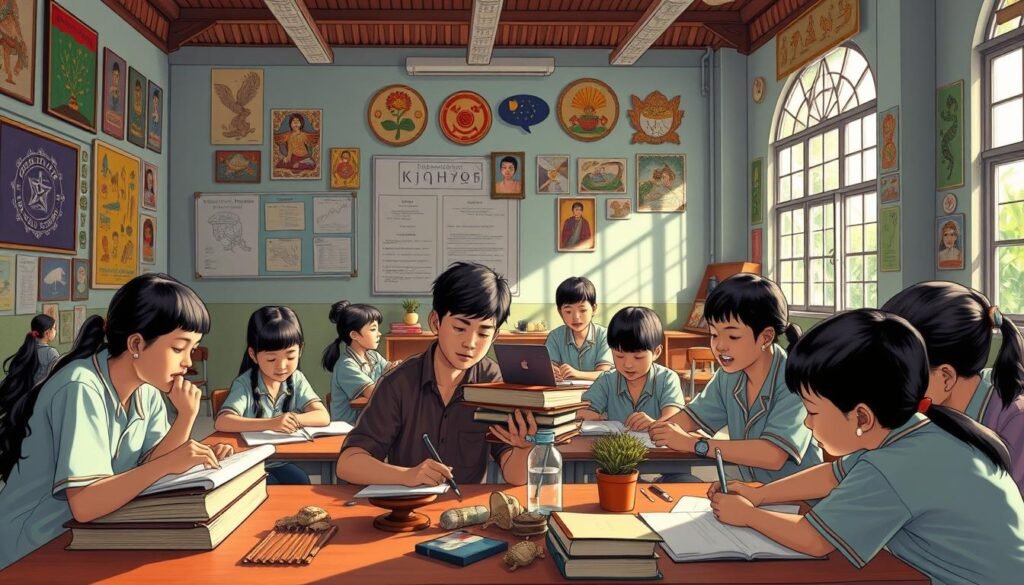
The Philippine education system faces challenges like lack of resources and outdated curricula. But, with the help of experts, the country aims for a more inclusive education system. Education can shape the Philippines’ future by promoting change and progress.
Education can change culture and society in many ways, such as:
- Promoting critical thinking and problem-solving skills
- Encouraging creativity and innovation
- Fostering a sense of social responsibility and civic engagement
By investing in education, the Philippines can build a more informed and skilled workforce. This can boost the economy and drive development. Education is vital for positive change in culture and society, and it should be a top priority in the country’s development plans.
Preserving Filipino Culture Amid Modern Influence
The Philippines is growing in many ways, but keeping Filipino culture and values alive is key. We can do this by supporting cultural sites, traditional practices, and indigenous knowledge. Research shows that keeping cultural heritage is vital for the country’s identity and values.
Studies point out the role of government in saving indigenous knowledge and cultural practices. For instance, the National Cultural Heritage Act of 2009 aims to protect cultural treasures and boost cultural tourism. Places like Vigan City and Intramuros are also being preserved to keep cultural landmarks alive.
Some important steps and hurdles in saving Filipino culture include:
- Promoting cultural heritage sites and traditional practices
- Supporting indigenous knowledge and cultural preservation
- Addressing challenges such as insufficient funding and climate change
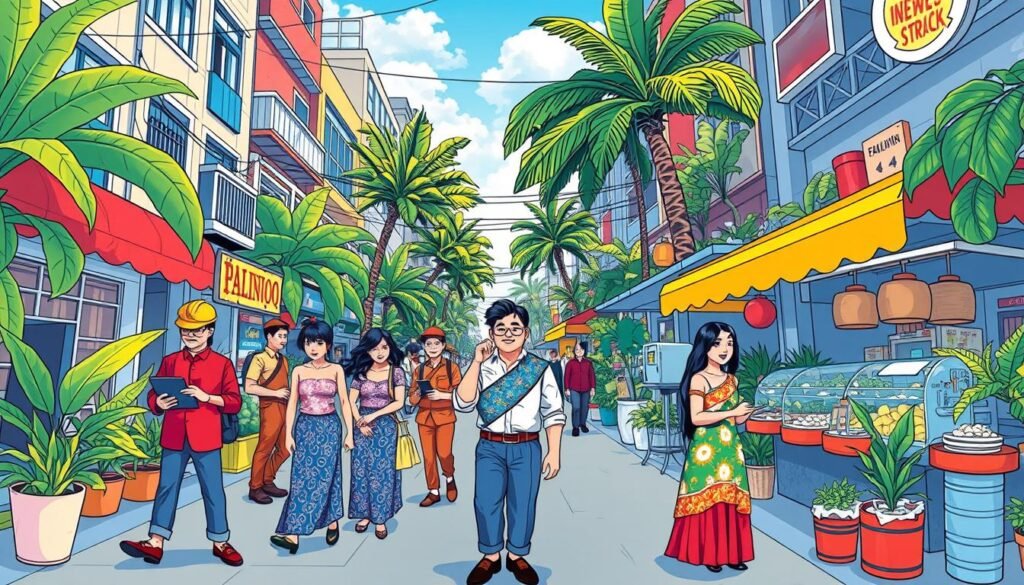
By focusing on preserving Filipino culture and values, the country can maintain a strong identity. This also helps in promoting cultural tourism and boosting the economy.
| Cultural Heritage Site | Location | Significance |
|---|---|---|
| Vigan City | Ilocos Sur | Spanish colonial architecture and cultural preservation |
| Intramuros | Manila | Historic walled city and cultural heritage site |
Balancing Act: Tradition vs. Modernity
The balance between tradition and modernity is a big challenge in Filipino society. The country is going through big cultural and economic change. It’s key to mix old values with new ways.
Every day, Filipinos face the task of keeping their culture alive while accepting change. They do this in many ways, like how they dress and what they eat. For example, they wear traditional clothes like baro’t saya and barong tagalog for special events. But they also follow modern fashion trends.
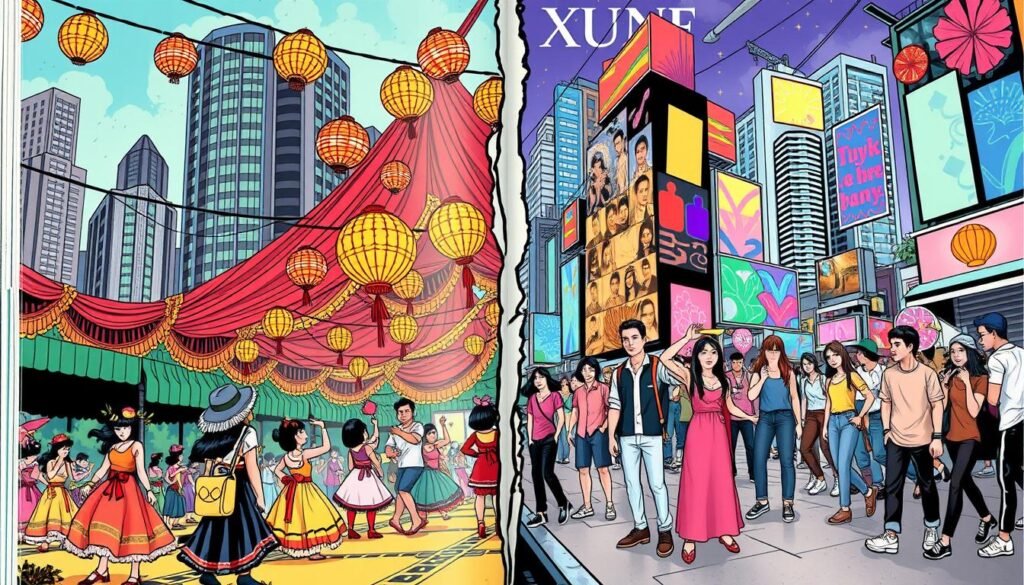
To deal with today’s fast pace, Filipinos have found ways to adapt. They use technology to stay connected and informed. They also mix old traditions with new ideas, like using traditional music in modern shows. And they make sure to spend quality time with family and keep up with traditional activities.
By balancing tradition and modernity, Filipinos keep their culture alive and vibrant. They also get to enjoy the good things that change brings.
Modernity’s Effect on Filipino Family Structures
The Philippines is seeing big changes in society, including family structures. Modern values like individualism and freedom are changing family life. Now, we see more nuclear families and single-parent homes.
A study on this change is found in research on social transformations. It shows how Filipino families are adapting to these new ways. The role of extended families, once key, is also changing with modernity.
Some big changes in Filipino families include:
- More focus on individual rights and freedoms
- More emphasis on education and personal growth
- Changing roles of family members, like women, in work and at home
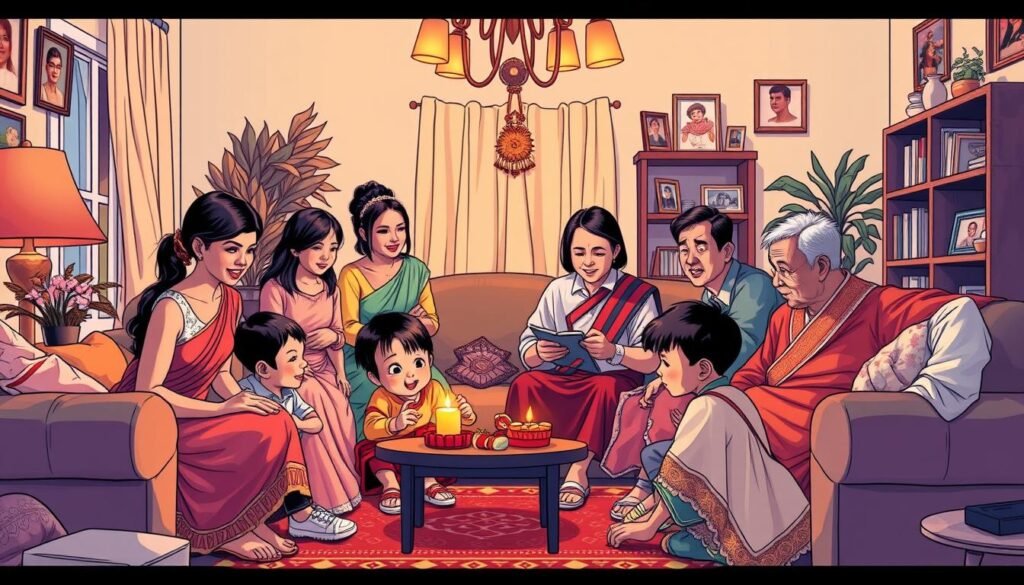
In summary, modernity’s impact on Filipino families is complex. It’s shaped by many factors, including values and progress. Understanding these changes is key as the Philippines moves forward.
Contemporary Filipino Art and Expression
Contemporary Filipino art is a vibrant mix of old traditions, colonial history, and new global views. This mix shows the country’s rich culture and its ability to change. Filipino artists use many ways to share their thoughts, from old to new art forms.
Some key points in contemporary Filipino art are the use of native materials, video, sound, and new tech. Also, the rise of independent art spaces and artist groups. These changes help artists connect with people in new ways. They also help show off Philippine traditional and modern arts.
What makes contemporary Filipino art special includes:
- Combining old and new ideas
- Using native and colonial influences
- Exploring different art forms, like painting, sculpture, digital art, and multimedia
- Talking about big issues, like poverty, religion, inequality, human rights, and the environment
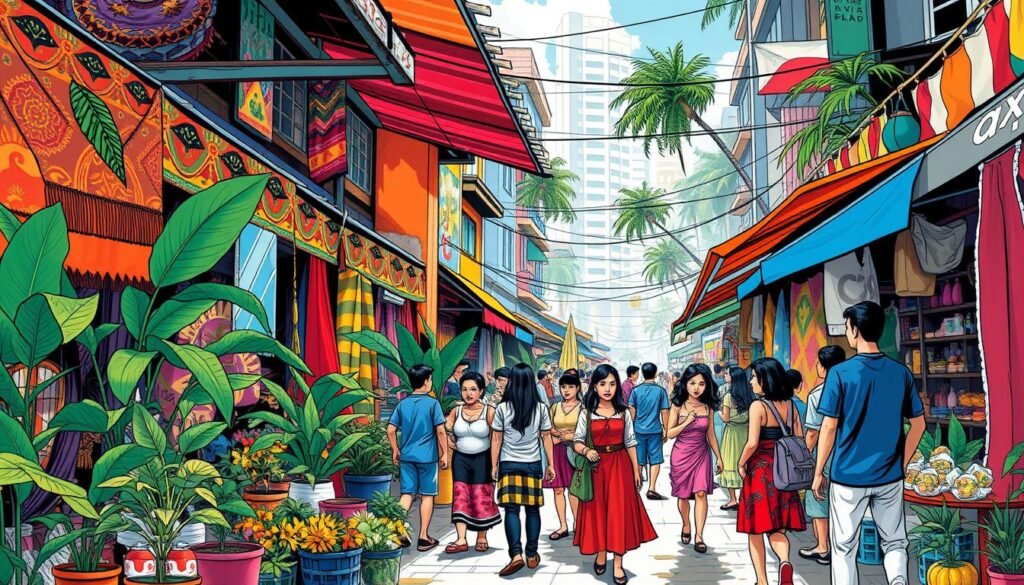
Overall, contemporary Filipino art is a strong way to share thoughts on social and political issues. It offers new views and stories that show the country’s unique culture and its ability to adapt to change.
| Art Movement | Time Period | Description |
|---|---|---|
| Modern Art | 1860s-1960s | Introduction of modernist concepts and techniques |
| Contemporary Art | 1970s-present | Emergence of new artistic movements and mediums |
| Postmodernism | late 1980s | Pastiche, bricolage, appropriation, and installation art |
The Evolution of Filipino Cuisine
Filipino cuisine is a mix of old and new flavors. It shows the country’s history and values. The evolution of Filipino cuisine shows how the country has grown. It welcomes new tastes and cooking ways, showing the importance of family and community.
Filipino food is known for its sweet, sour, and salty tastes. Spicy flavors are common in some areas. Ingredients like kalamansi and pili nuts add special flavors to dishes. Adobo, a favorite stew, is simple yet lasts for days.
Some top Filipino dishes are:
- Lechon (whole roasted pig)
- Longganisa (Philippine sausage)
- Tapa (cured beef)
- Adobo (vinegar and soy sauce-based stew)
- Sinigang (meat or seafood with vegetables in sour broth)
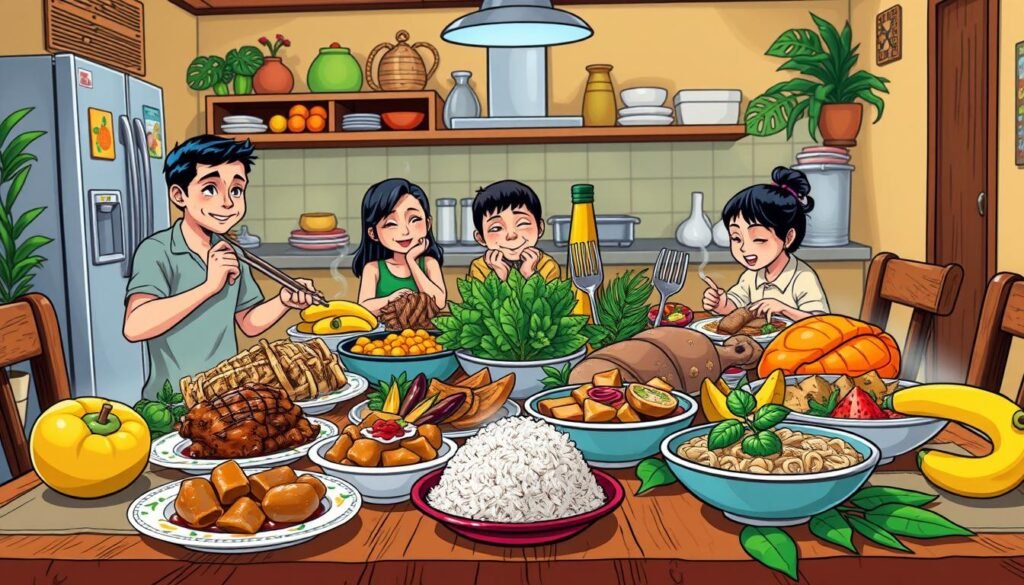
Filipino food comes from many influences. These include Spanish, Chinese, Malay, and American tastes. The Filipino people live in over 100 countries, sharing their food and values of adaptability and strength.
| Dish | Description |
|---|---|
| Lechon | Whole roasted pig |
| Longganisa | Philippine sausage |
| Tapa | Cured beef |
Modernity and Filipino Identities
Modernity has changed how Filipinos see themselves, creating many identities. They face the challenge of keeping their culture alive while adapting to change. This balance is key to the country’s future, as towards Filipino modernity points out.
Some important parts of modern Filipino identities include:
- Globalization and its influence on cultural exchange
- The impact of free market capitalism on individual rights and freedoms
- The role of education in promoting culture and facilitating change
As Filipinos evolve, they must keep their culture alive while embracing new ideas. This is shown in Jose Rizal’s fight for freedom and equality of cultures.
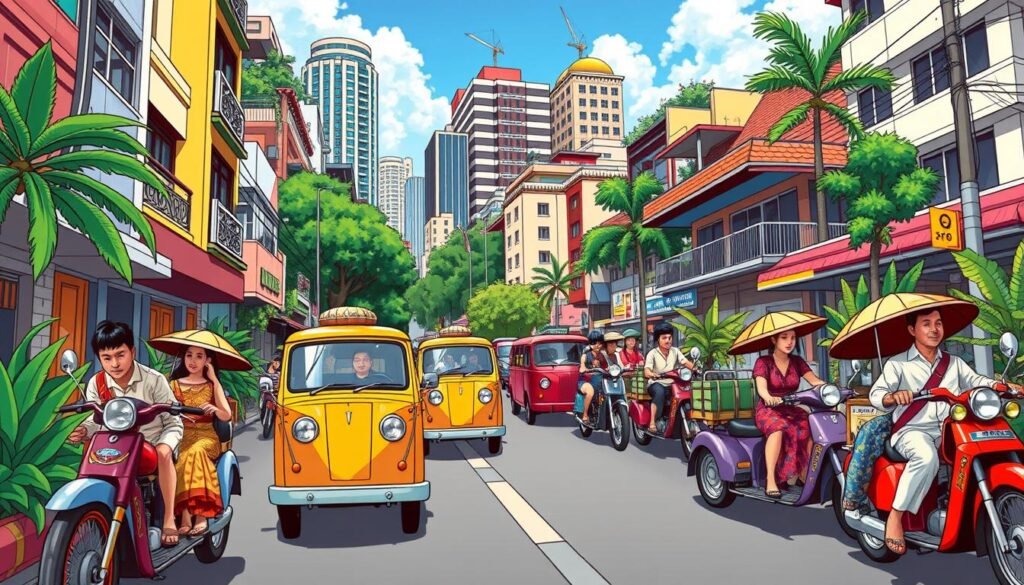
Multiple Identities in a Modern World
In today’s world, Filipinos struggle with many identities. They balance their culture with their modern, global selves. This balance affects their rights and duties to their community and culture.
The Influence of Globalization
Globalization has shaped Filipino identities, creating new cultures and exchanging ideas. As Filipinos connect with the world, they must also protect their culture and handle change wisely.
Impact of Social Media on Filipino Society
Social media is a big part of life in the Philippines. Many Filipinos use digital platforms to connect and share. This has changed how people talk and share info.
Platforms like Facebook, Twitter, and Instagram have changed communication in the Philippines. Filipinos are among the most active users worldwide.
With over 86 million users, social media shapes values and influences social movements. It helps mobilize action and raise awareness on issues like the environment and human rights. But, it also brings challenges like fake news, bullying, and privacy issues.
Recent stats show Filipinos spend 3 hours and 34 minutes daily on social media. 73.4% use it to stay in touch with friends and family. This shows social media’s big impact on Filipino society.
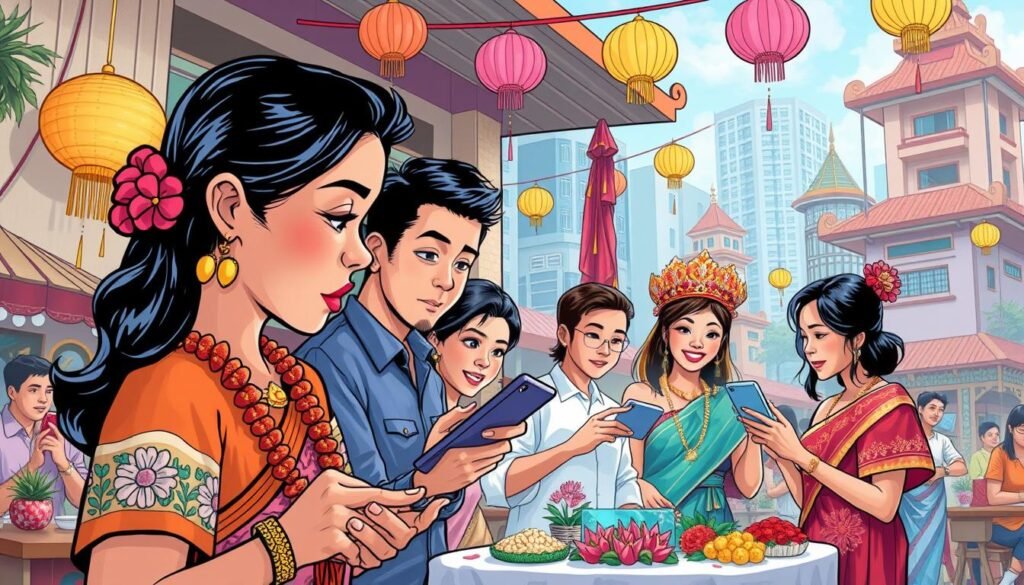
As social media grows, it’s key for Filipinos to understand its effects. By promoting digital literacy and responsible use, they can use social media for good. This way, they can drive progress and uphold their values.
Economic Growth and Modern Development
The Philippines is seeing big changes in its economy and modern development. These changes come from new business ideas and the work of Overseas Filipino Workers (OFWs). The country is adopting new technologies and practices to keep up in the global market.
Some key factors contributing to this growth include:
- Increased investment in infrastructure and technology
- Growing demand for Filipino products and services
- Expansion of the service sector, including business process outsourcing and tourism
OFWs have a huge impact on the country’s modern economy. Their money sent back home boosts the economy. Their experiences with different cultures make the society more open and adaptable. As the Philippines keeps growing, its culture will likely change a lot.
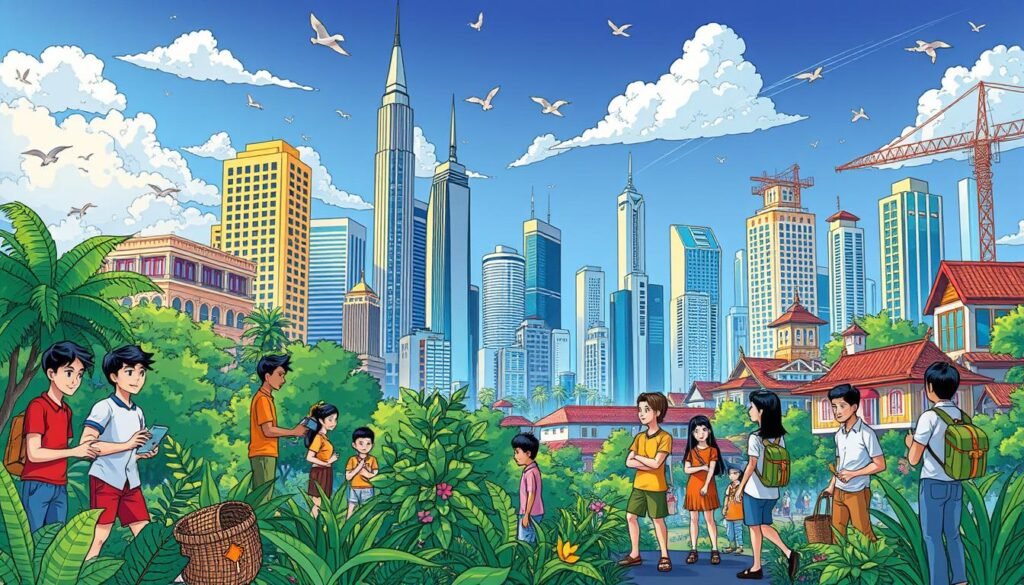
In conclusion, the Philippines is ready for more economic growth and modern development. This growth comes from new business ideas and the work of OFWs. As the country changes, its culture will also go through big changes, driven by the need for modernization and development.
| Factor | Impact on Economic Growth |
|---|---|
| Investment in Infrastructure | Increased productivity and competitiveness |
| Growing Demand for Filipino Products | Stimulated economic growth and job creation |
| Expansion of the Service Sector | Diversified economy and increased foreign exchange earnings |
Future Trends: Philippine Modernity Ahead
The Philippines is moving forward, but it’s not without its challenges. The country wants to keep its rich values while also making progress. Sociologists say it’s a fine line to walk, blending old traditions with new ways.
Technology, education, and city growth have changed how Filipinos live. Yet, the heart of their culture remains strong. Experts believe we’ll see more of combining old traditions with today’s trends. This will create a unique Filipino modernity that honors the past and looks to the future.
But, there are obstacles in keeping the Filipino identity strong in a world that’s getting smaller. Keeping family ties, community spirit, and respect for heritage sites will need careful planning. As the Philippines changes, finding the right mix of tradition and modernity is key to its growth and identity.
FAQ
What is the remarkable ability of the Filipino people?
Filipinos are amazing at mixing old traditions with new ways. They keep their culture alive while embracing modern changes.
How is modernity perceived in the Filipino context?
For Filipinos, modernity means more than just Western ideas. It’s shaped by the country’s history, culture, and traditions.
What is the historical background of modernity in the Philippines?
The Philippines has seen many changes, thanks to different colonial powers. The Spanish, American, and Japanese periods have all shaped Filipino society.
What are the key elements of Filipino modernity?
Filipino modernity includes tech, city life, and new ways of living. Technology and social media have changed how people talk and connect. Cities have also changed society a lot.
What is the role of education in modern Filipino society?
Education is key for Filipinos to move up in life. But, the education system faces big challenges like old books and not enough schools.
How are Filipino cultural traditions being preserved amid modern influence?
Keeping Filipino culture alive is tough with modern changes. Efforts are being made to save old customs and keep cultural sites important.
How are Filipinos balancing tradition and modernity in their daily lives?
It’s hard for Filipinos to balance old and new ways. Different ages have different values, making it tricky. People find ways to deal with this every day.
How has modernity affected Filipino family structures?
Modern life has changed Filipino families. The old extended family system is fading, with more nuclear families and single parents.
How is contemporary Filipino art and expression influenced by tradition and modernity?
Filipino art today is full of life and variety. It shows the country’s rich culture and new influences. Artists use many ways to express themselves, mixing old and new.
How is Filipino cuisine evolving with the influence of modernity?
Filipino food is a mix of old and new tastes. The country’s food scene is growing, with new twists on old dishes, mainly in cities.
How are Filipino identities shaped by modernity and globalization?
Filipino identities are complex, blending old culture with new influences. Globalization has created many identities, as Filipinos navigate different worlds.
What is the impact of social media on Filipino society?
Social media has changed Filipino society a lot. It helps people connect and share their views. It’s also key in social movements, helping people fight for change.
How is economic growth and modern development shaping the Philippines?
The Philippines is growing economically, aiming to be a big player globally. New business ideas and the influence of OFWs are helping the economy grow.
What are the future trends and challenges for Philippine modernity?
The Philippines’ future is uncertain, with both challenges and chances ahead. Keeping the culture alive while embracing new things is a big concern.
Source Links
- Culture Clash: Traditional Values and Modern Challenges in Filipino Families – https://mariaisquixotic.com/modern-challenges-filipino-families/
- Discover Filipino Culture: Festivals, Traditions, and Values – https://makeyourasia.com/philippines/filipino-culture.html
- Modernity and the filipino – https://www.slideshare.net/slideshow/modernity-and-the-filipino/237165372
- Lecture Notes 5 – https://www.ateneo.edu/sites/default/files/2022-10/JVO 1 LECTURE by RSDavid.pdf
- PHENOMENA – https://e-journal.usd.ac.id/index.php/JOLL/article/download/390/337
- Colonial Contractions: The Making of the Modern Philippines, 1565–1946 – Oxford Research Encyclopedia of Asian History – https://history.washington.edu/sites/history/files/documents/research/vicente_l._rafael_colonial_contractions.pdf
- Filipino Postmodernity: Quo Vadis? – https://archium.ateneo.edu/cgi/viewcontent.cgi?article=1065&context=philo-faculty-pubs
- PDF – https://pssc.org.ph/wp-content/pssc-archives/Philippine Sociological Review/1999/04_Modernity and the Underdevelopment of Sociological Theory in the Philippines.pdf
- PDF – http://repository.upi.edu/47421/6/D_IPS_1608348_Chapter5.pdf
- Modernity and the Filipino child – https://opinion.inquirer.net/81285/modernity-and-the-filipino-child
- PDF – https://educ.upd.edu.ph/wp-content/uploads/2024/04/PJES-DOI-04162024.pdf
- Preserving Socio-Cultural Practices Exploring Resilience and the Impact of Government Initiatives among the Manobo in the Philippines – https://www.scirp.org/journal/paperinformation?paperid=128016
- Cultural Heritage and Development: Balancing Modernization with Tradition in the Philippines – https://richestph.com/cultural-heritage-and-development-balancing-modernization-with-tradition-in-the-philippines/
- Humanity and modernity: A balancing act – Diplo – https://www.diplomacy.edu/blog/humanity-and-modernity-balancing-act/
- A Balancing Act of Tradition and Modernity – https://loumain.com.au/blog/cultural-buildings-places-of-worship-construction/a-balancing-act-of-tradition-and-modernity
- Balancing Traditional Values And Modern Influences – FasterCapital – https://fastercapital.com/topics/balancing-traditional-values-and-modern-influences.html
- Consuming Capitalist Modernity in the Media Cultures of 1930s and 1960s Manila’s Commercial Streets | The Journal of Asian Studies | Cambridge Core – https://www.cambridge.org/core/journals/journal-of-asian-studies/article/consuming-capitalist-modernity-in-the-media-cultures-of-1930s-and-1960s-manilas-commercial-streets/156A084C678D5669846642BDCE80EC3B
- "Conquest and Resistance: Intersections of Colonialism and Modernity in Twentieth Century Philippine Architectures" – https://www.academia.edu/28874244/_Conquest_and_Resistance_Intersections_of_Colonialism_and_Modernity_in_Twentieth_Century_Philippine_Architectures_
- ISSUE 8 – FINAL! v12.pmd – https://www.plarideljournal.org/wp-content/uploads/2015/10/2007-02-Call-Center-and-the-Modern-Individual-by-Princess-Diane-H.-Dagohoy.pdf
- CONTEMPORARY ARTS in the PHILIPPINES.pptx – https://www.slideshare.net/slideshow/contemporary-arts-in-the-philippinespptx/266612196
- Contemporary Arts in the Philippines: An Introduction – https://bluprint-onemega.com/architecture/heritage/an-introduction-to-contemporary-arts-in-the-philippines/
- "Graffiti and Filipino Contemporary Art: A Vibrant Canvas of Culture and Expression" – https://www.linkedin.com/pulse/graffiti-filipino-contemporary-art-vibrant-canvas-culture-de-vera
- Filipino cuisine – https://en.wikipedia.org/wiki/Filipino_cuisine
- Filipino Cuisine: A Rich Tapestry Of Culinary Traditions – https://www.eliteplusmagazine.com/Article/950/Filipino_Cuisine__A_Rich_Tapestry_Of_Culinary_Traditions
- Modern Culture vs. Traditional culture: Why I choose the former – https://www.getrealphilippines.com/2022/05/modern-over-traditional-culture/
- Rizal and modernity – https://opinion.inquirer.net/20005/rizal-and-modernity
- Social Media Statistics in the Philippines [Updated 2024] – https://www.meltwater.com/en/blog/social-media-statistics-philippines
- Social Media in the Philippines – https://www.nipino.com/social-media-in-the-philippines
- Unpacking The Impact Of Social Media On Filipinos – https://www.camella.com.ph/unpacking-the-impact-of-social-media-on-filipinos/
- PDF – https://www.nepjol.info/index.php/JAPFCSC/article/download/67004/50953/195833
- Modernization | Nature, Features, Examples, & Facts | Britannica – https://www.britannica.com/topic/modernization
- Modernization: Is it Pathway to Achieving Sustainable Economic Growth and Investments – https://papers.ssrn.com/sol3/papers.cfm?abstract_id=2717083
- PDF – https://pssc.org.ph/wp-content/pssc-archives/Institute of Philippine Culture/Select Articles and Papers/The Impact of Modernization on Fil. Adolescents.pdf

